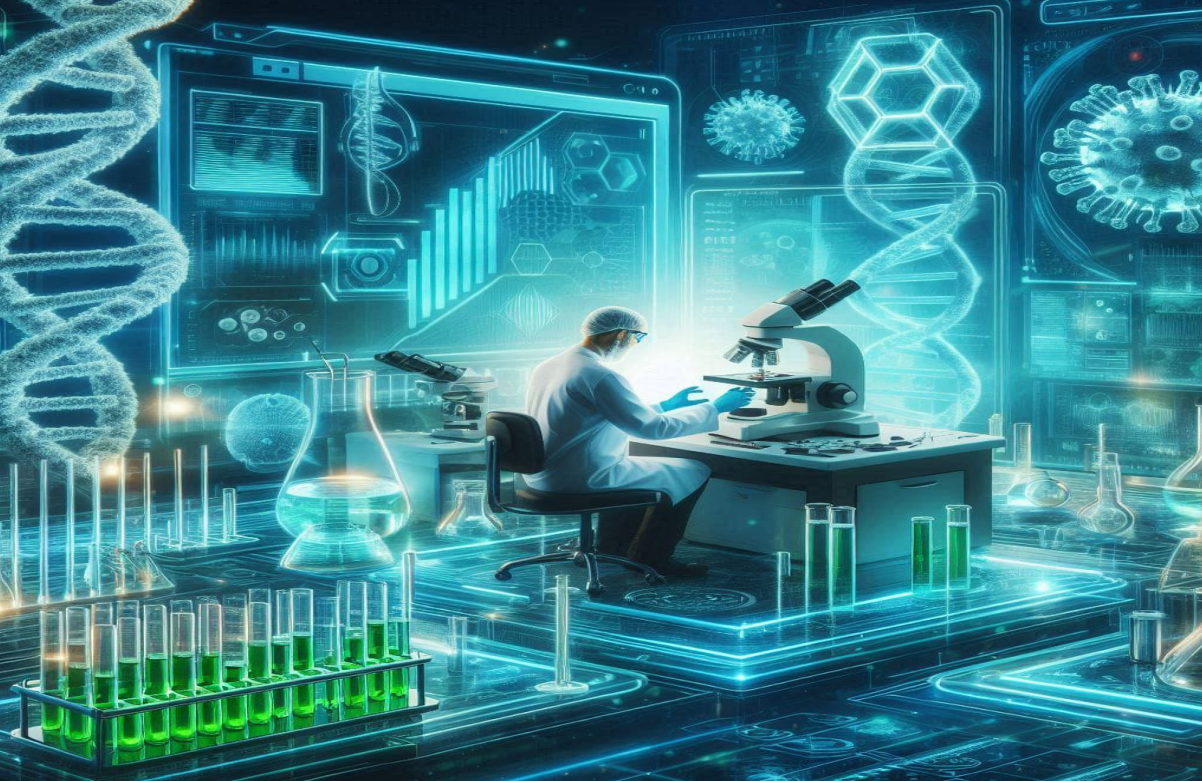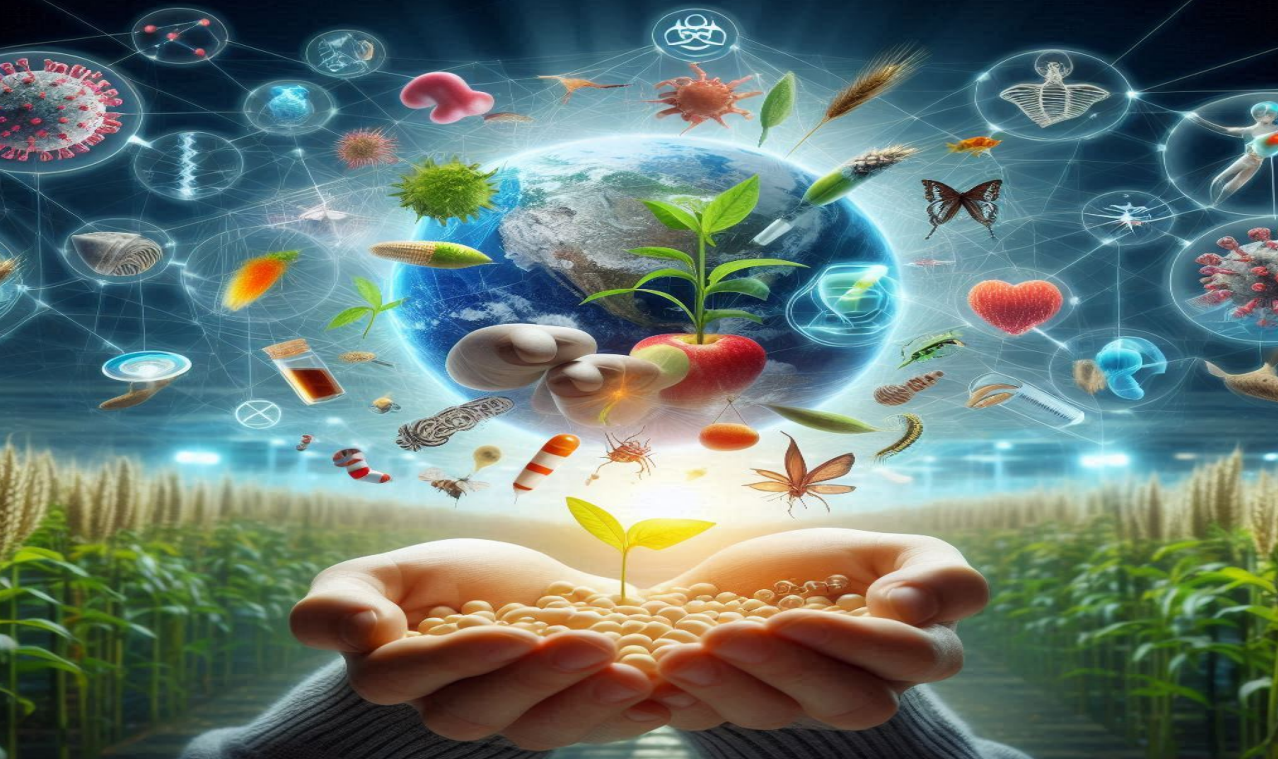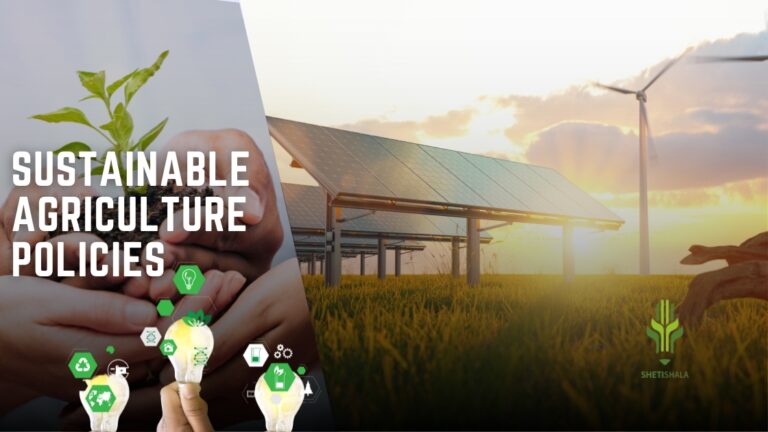Introduction
Explore the world of genetic engineering in agriculture through our in-depth blog. Discover how genetically engineered crops are revolutionizing farming with improved yield, pest, and disease resistance. Delve into the controversies and concerns surrounding these innovations, including their impact on the environment and human health. We also examine the regulatory and safety assessments that ensure these crops are safe for consumption and the planet. Stay informed about the latest advancements and debates in genetic engineering, and how they are shaping the future of sustainable agriculture in this blog which is written by Swayamdip Telang.
Define
Genetic engineering in agriculture, also known as genetic modification
biotechnology, is the process of a altering the genetic code of plants, animals, or
microorganisms to improve their characteristics or performance. This is done by
manipulating the DNA molecule, which contains the genetic instructions for an
organism’s development and function.

Key aspects of genetic engineering in agriculture
Techniques
1.Recombinant DNA Technology:
Involves the insertion of genes from one organism into another to confer new traits.
2.CRISPR-Cas9:
A precise and efficient gene-editing tool that can add, remove, or alter genetic material at specific locations in the genome. 3.Gene Cloning: The process of creating copies of specific genes to introduce into crops or livestock
Benefits
1. Mechanisms for Improving Crop Yields
1.Enhanced Photosynthesis:
Genetic modifications can increase the efficiency of
photosynthesis, allowing plants to convert more sunlight into energy, which boosts
growth and yields.
2.Pest and Disease Resistance:
Introducing genes that confer resistance to pests
and diseases reduces crop losses, ensuring higher yields.
3.Abiotic Stress Tolerance:
Crops can be engineered to withstand environmental
stresses such as drought, salinity, and extreme temperatures, which typically reduce
yields.
4.Nutrient Use Efficiency:
Genetic modifications can improve a plant’s ability to absorb and utilize nutrients from the soil, resulting in better growth and higher yields.
5.Growth Regulators:
Introducing or modifying genes related to plant hormones can
optimize growth rates and development stages, enhancing overall productivity

Genetically Engineered Crops with Improved Yields
1.Bt Crops ( Cotton, Bt Corn):
These crops are engineered to produce a protein from the bacterium Bacillus thuringiensis, which is toxic to specific insect pests. This built-in pest
resistance reduces crop damage and increases yields.
2.Drought-Tolerant Maize:
Developed to withstand water scarcity, these varieties can maintain higher productivity during drought conditions, ensuring stable yields.
3.Nitrogen-Use Efficient Crops:
Plants engineered to use nitrogen more efficiently
require less fertilizer, leading to lower costs and higher yields due to better growth. Impact on Agriculture
1.Food Security:
Higher crop yields contribute to increased food production, helping to meet the demands of a growing global population.
2.Economic Benefits:
Farmers can achieve higher profits due to increased productivity
and reduced costs associated with pesticides and fertilizers.
3.Sustainable Agriculture:
Improved yields on existing farmland reduce the need to clear
additional land for agriculture, helping to conserve natural ecosystems and biodiversity.
4.Adaptation to Climate Change:
Crops engineered for stress tolerance are better
equipped to cope with the adverse effects of climate change, ensuring consistent yields under varying conditions.
2. Pest and Disease Resistance
1.Bt Toxins:
Genes from the bacterium Bacillus thuringiensis (Bt) are inserted into crops, allowing them to produce Bt toxins that are lethal to certain insect pests but safe for
humans and other
animals.
2.RNA Interference (RNAi):
This technique involves inserting genes that produce RNA molecules to silence specific pest or pathogen genes, disrupting their ability to harm the plant.
3.Resistance Genes (R-genes):
These genes, often sourced from other plants, can
recognize and trigger defenses against specific pathogens, such as viruses, bacteria, and fungi.
4. Antimicrobial Proteins:
Genes encoding antimicrobial peptides or proteins can be
introduced to confer resistance against a wide range of microbial pathogens.
5.Enhanced Physical Barriers:
Genetic modifications can strengthen a plant’s physical
structures, such as cell walls, making it more difficult for pests and pathogens to penetrate and cause damage

Examples of Genetically Engineered Crops with Pest and Disease Resistance
1.Bt Crops ( Bt Cotton, Bt Corn):
These crops produce Bt toxins that target specific insect
pests like the European corn borer and cotton bollworm, significantly reducing crop
losses and pesticide use.
2.Virus-Resistant Papaya:
Engineered to resist the papaya ringspot virus (PRSV), this
genetically modified papaya has revitalized papaya production in areas affected by the virus.
3.Late Blight-Resistant Potatoes:
Modified to resist Phytophthora infestans, the pathogen responsible for the devastating Irish potato famine, these potatoes offer protection
against this serious disease.
Impact on Agriculture
1.Reduced Chemical Use:
Genetic resistance to pests and diseases decreases the need for chemical pesticides, benefiting the environment and human health.
for more information about organic farming visit out blogs.
2.Cost Savings:
Farmers save money on pesticides and other pest management
practices, leading to higher profitability.
3.Increased Crop Yields:
With reduced losses from pests and diseases, overall crop
productivity improves, contributing to food security.
3. Nutritional Enhancement
1.Bio fortification:
The process of increasing the nutritional value of crops by
adding essential vitamins and minerals.
2.Enhanced Metabolic Pathways:
Modifying plants to increase the production of
beneficial compounds, such as antioxidants, amino acids, and fatty acids.
3.Reduced Antinutrients:
Engineering crops to lower levels of substances that inhibit the absorption of nutrients, such as phytic acid.
Examples of Nutritionally Enhanced Crops
1.Golden Rice:
Engineered to produce beta-carotene, a precursor of vitamin A. This
helps combat vitamin A deficiency, which can cause blindness and immune system deficiencies.
2.Iron-Rich Beans:
Biofortified to contain higher levels of iron, helping to address iron deficiency anemia, a common nutritional issue in many developing countries. 3.Vitamin-Enriched Cassava: Modified to increase the content of vitamins A and E, as
well as iron and protein, providing a more nutritious staple food for regions dependent
on cassava.
Impact on Agriculture and Public Health
1.Combating Malnutrition:
Nutritionally enhanced crops can help address deficiencies in essential vitamins and minerals, improving overall health and reducing the incidence of related diseases.
2.Improving Food Quality:
Enhancing the nutritional content of staple crops can
provide more balanced diets, especially in regions where food variety is limited.
3.Economic Benefits:
Healthier populations contribute to economic productivity, reducing healthcare costs and increasing the quality of life.
4. Enhancing Environmental Stress Tolerance
Introducing genes that improve water-use efficiency, root
development, and stress response mechanisms.
1 Drought Tolerance:
to help plants survive and thrive in water-limited conditions.
2 Salt Tolerance:
Modifying plants to regulate ion transport and compartmentalization, reducing the toxic effects of high soil salinity. 3 Temperature Tolerance: Enhancing the ability of plants to withstand extreme heat
or cold by modifying genes involved in heat shock proteins, antifreeze proteins, and
other protective mechanisms.
3 Oxidative Stress Tolerance:
Increasing the production of antioxidants and other
protective compounds to help plants mitigate damage from reactive oxygen species generated under stress conditions.
Examples of Genetically Engineered Crops with Enhanced Stress Tolerance
1 Drought-Tolerant Maize (Corn):
Engineered to express genes that improve water
uptake and retention, allowing for higher yields under drought conditions.
2 Salt-Tolerant Rice:
Modified to thrive in saline soils by regulating sodium uptake and enhancing salt tolerance mechanisms.
3 Cold-Resistant Tomatoes:
Enhanced to withstand lower temperatures, reducing the risk of frost damage and extending the growing season.
4.Heat-Tolerant Wheat:
Engineered to maintain productivity in high-temperature
environments by enhancing heat shock proteins and other protective responses.
Benefits of Environmental Stress Tolerance
1 Increased Crop Yields:
Crops that can withstand environmental stresses produce
higher yields, contributing to food security and agricultural productivity.
2 Sustainable Farming:
Reducing the reliance on water and other inputs supports more sustainable agricultural practices, conserving natural resources.
3 Adaptation to Climate Change:
Stress-tolerant crops are better equipped to handle the variability and extremes associated with climate change, ensuring stable food supplies.
4 Economic Stability:
Farmers benefit from more consistent yields and reduced losses, leading to greater economic stability and resilience.

Controversies and Concerns
Positive Environmental Impacts:
1.Reduced Pesticide Use:
Crops engineered to be pest-resistant can reduce the need for
chemical pesticides, which can benefit the environment by decreasing pesticide runoff
into water sources and reducing harm to non-target organisms, including beneficial
insects.
2.Lower Herbicide Use:
Herbicide-tolerant crops can allow for more efficient weed control, potentially reducing the overall amount of herbicides used and thus minimizing their
environmental impact.
3.Soil Conservation:
Certain GM crops enable practices like no-till farming, which helps in maintaining soil structure, reducing erosion, and preserving soil health.
Negative Environmental Impacts:
1.Gene Flow:
The transfer of genes from GM crops to wild relatives or non- GM crops
through cross-pollination can lead to unintended ecological consequences and the spread of herbicide resistance to wild plant populations.
2.Resistance Development:
Pests and weeds can evolve resistance to the traits
engineered into GM crops, leading to “super pests” and “super weeds” that are more
difficult to control and require even more potent chemical treatments.
3.Non-Target Effects:
The impact of GM crops on non-target organisms, including
beneficial insects, soil microbes, and other wildlife, is not fully understood and may pose risks to ecosystem health.
Health Risks:
The health risks associated with genetically modified (GM) foods have been a topic of
extensive scientific research and public debate. While the majority of studies and
regulatory assessments indicate that GM foods currently on the market are safe to
consume, there are several key areas of concern and ongoing investigation:
Potential Health Risks:
1.Allergenicity:
One concern is that inserting new genes into crops could introduce new allergens or increase the levels of existing allergens. Regulatory bodies typically assess GM foods for potential allergenicity before approval.
2.Toxicity:
There is a possibility that genetic modifications could lead to the production of new toxins in food plants. However, extensive testing is conducted to ensure that GM foods do not contain harmful levels of toxins.
3.Nutritional Changes:
Genetic modifications could inadvertently alter the nutritional
content of crops, potentially reducing beneficial nutrients or introducing harmful
substances. However, biofortification efforts aim to enhance nutritional content.

Regulatory and Safety Assessments:
1Rigorous Testing:
GM foods undergo rigorous safety assessments before they are
approved for commercial use. These assessments typically include allergenicity testing, toxicity studies, nutritional analysis, and comparisons with non-GM counterparts.
2.Scientific Consensus:
Major scientific organizations, including the World Health
Organization (WHO), the American Medical Association (AMA), and the National
Academy of Sciences (NAS), have stated that GM foods currently available on the
market are no more risky to human health than conventional foods.
Economic and Ethical Issues:
Economic Issues:
Seed Costs and Access:
1.High Costs:
GM seeds are often more expensive than conventional seeds due to the costs associated with research, development, and patenting.
2.Access for Small Farmers:
Small and resource-poor farmers may struggle to afford GM seeds, potentially exacerbating economic inequalities in agriculture. Market Concentration:
1.Industry Control:
A few large biotechnology companies dominate the GM seed market, leading to concerns about monopolistic practices and reduced competition.
2.Dependency:
Farmers may become dependent on a limited number of seed suppliers, reducing their bargaining power and choice.
Intellectual Property and Patents:
Patents on Life Forms:
Patenting genetically modified seeds grants companies
exclusive rights to their use, raising ethical questions about the ownership of genetic
resources
Seed Saving:
Traditional practices of saving and replanting seeds are restricted by
patent laws, forcing farmers to purchase new seeds each season.
Ethical Issues:
Food Security and Sovereignty:
1.Equity and Access:
Ethical concerns arise around ensuring that the benefits of GM technology are equitably distributed and accessible to all, particularly marginalized
communities.
2.Control Over Food Systems:
There are debates over who controls food production
systems and the impact of GM crops on local and traditional agricultural practices.
Environmental Ethics:
1.Biodiversity:
The impact of GM crops on biodiversity and the environment raises
ethical questions about the long-term sustainability of agricultural ecosystems.
2.Precautionary Principle:
Ethical considerations include whether the potential risks of
GM crops warrant a precautionary approach in their development and deployment.

Labeling and Consumer Rights:
1. Informed Choice:
Advocates for labeling argue that consumers have the right to know if their food contains GM ingredients and to make informed choices based on personal, health, or ethical reasons.
2.Transparency:
Ethical transparency in labeling and marketing GM foods is essential to build consumer trust and respect individual preferences
Animal Welfare:
1.Genetic Modification of Livestock:
Ethical issues related to the genetic modification of
animals for food production include concerns about animal welfare, naturalness, and the moral implications of altering animal genomes.
Conclusion:
The successful and responsible deployment of genetic engineering in agriculture
depends on a balanced approach that maximizes benefits while minimizing risks. This involves robust regulatory frameworks, transparent communication, ethical
considerations, and inclusive policies that ensure equitable access and address the
needs of diverse stakeholders.
By fostering collaboration between scientists, policymakers, farmers, and consumers, genetic engineering can contribute to a more
sustainable, secure, and resilient agricultural future.




